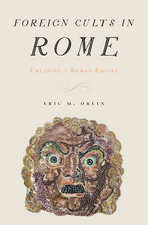The Language of Ruins: Greek and Latin Inscriptions on the Memnon Colossus
Autor Patricia A. Rosenmeyeren Limba Engleză Hardback – 10 mai 2018
Preț: 602.50 lei
Preț vechi: 827.06 lei
-27% Nou
Puncte Express: 904
Preț estimativ în valută:
115.32€ • 125.31$ • 96.94£
115.32€ • 125.31$ • 96.94£
Carte tipărită la comandă
Livrare economică 09-15 aprilie
Preluare comenzi: 021 569.72.76
Specificații
ISBN-13: 9780190626310
ISBN-10: 0190626313
Pagini: 296
Ilustrații: 12 illustrations
Dimensiuni: 155 x 236 x 25 mm
Greutate: 0.75 kg
Editura: Oxford University Press
Colecția OUP USA
Locul publicării:New York, United States
ISBN-10: 0190626313
Pagini: 296
Ilustrații: 12 illustrations
Dimensiuni: 155 x 236 x 25 mm
Greutate: 0.75 kg
Editura: Oxford University Press
Colecția OUP USA
Locul publicării:New York, United States
Recenzii
The Language of Ruins' will, I suspect, be the definitive account of the Memnon inscriptions for many years to come.
[a] rich and rewarding book. The Language of Ruins will be of interest to classicists studying topics as diverse as Roman antiquarianism, ancient pilgrimage and elite tourism, and the reception of Homer and Sappho in the first few centuries AD. The book also has much to offer those working on Egyptomania, the cross-cultural understanding of ruins, and the entanglement of vernacular and learned as well as ancient and modern discourses about antiquities ... Rosenmeyer should be commended for breathing life into all the Greek and Latin inscriptions on the colossus.
A very readable account of a well-researched but relatively little-known subject area... This book is to be very highly recommended, blending as it does the Egyptian, Greek and Roman religious ideas and experiences.
In this brilliant study, one of antiquity's most exciting collections of inscriptions finally receives the thoughtful, comprehensive analysis it deserves, complete with a full text and translation. Patricia Rosenmeyer brings her deep knowledge of Greek literature to bear on the religious, poetic, and historical dimensions of the Memnon corpus, paying special attention to the role of women as authors and pilgrims, and to post-classical receptions of the monument. An invaluable contribution to the history of cultural exchange during the Roman Empire.
Patricia Rosenmeyer's reading of the sources addresses issues that range from sacred tourism in the Roman Empire and the motives, status, and cultural conditioning of the Greek and Roman visitors to the site to the poetics of inscription, relations between the fragmentary and the colossal, and the erasure of Egypt in the extant sources. The final chapter updates this fascinating story, treating the rediscovery of the image by travelers of the eighteenth and nineteenth centuries and the place it claimed in the European imaginary.
The statue of Memnon in Egypt, whose voice, it is said, was heard at sunrise from its absent head, was a popular tourist site under the Empire, and an irresistible opportunity for inscription, ranging from graffiti to literary composition. Rosenmeyer, with charm and skill, follows the many traces of this uncanny story, from ancient to modern times.
[a] rich and rewarding book. The Language of Ruins will be of interest to classicists studying topics as diverse as Roman antiquarianism, ancient pilgrimage and elite tourism, and the reception of Homer and Sappho in the first few centuries AD. The book also has much to offer those working on Egyptomania, the cross-cultural understanding of ruins, and the entanglement of vernacular and learned as well as ancient and modern discourses about antiquities ... Rosenmeyer should be commended for breathing life into all the Greek and Latin inscriptions on the colossus.
A very readable account of a well-researched but relatively little-known subject area... This book is to be very highly recommended, blending as it does the Egyptian, Greek and Roman religious ideas and experiences.
In this brilliant study, one of antiquity's most exciting collections of inscriptions finally receives the thoughtful, comprehensive analysis it deserves, complete with a full text and translation. Patricia Rosenmeyer brings her deep knowledge of Greek literature to bear on the religious, poetic, and historical dimensions of the Memnon corpus, paying special attention to the role of women as authors and pilgrims, and to post-classical receptions of the monument. An invaluable contribution to the history of cultural exchange during the Roman Empire.
Patricia Rosenmeyer's reading of the sources addresses issues that range from sacred tourism in the Roman Empire and the motives, status, and cultural conditioning of the Greek and Roman visitors to the site to the poetics of inscription, relations between the fragmentary and the colossal, and the erasure of Egypt in the extant sources. The final chapter updates this fascinating story, treating the rediscovery of the image by travelers of the eighteenth and nineteenth centuries and the place it claimed in the European imaginary.
The statue of Memnon in Egypt, whose voice, it is said, was heard at sunrise from its absent head, was a popular tourist site under the Empire, and an irresistible opportunity for inscription, ranging from graffiti to literary composition. Rosenmeyer, with charm and skill, follows the many traces of this uncanny story, from ancient to modern times.
Notă biografică
Patricia A. Rosenmeyer is George L. Paddison Professor of Classics at the University of North Carolina at Chapel Hill.

























